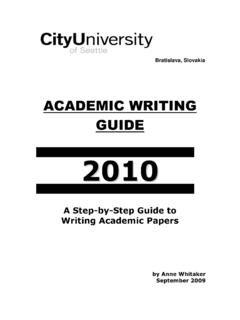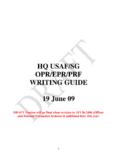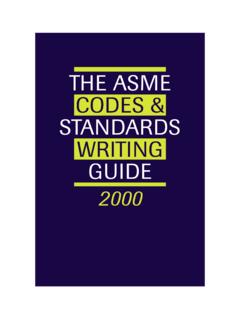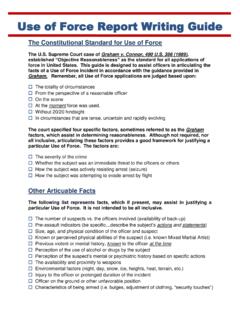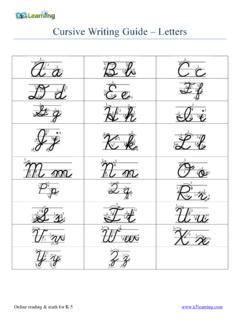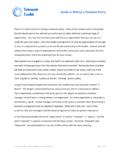Transcription of Writing - wiley-docs.com
1 Writing for PublicationAn easy to follow guide for nurses interested in publishing their workAn exclusive publication from WileyWiley s Nursing JournalsWiley is a leading publisher of nursing and healthcare journals, presenting the very best in academic research and clinical expertise. With many of the top-ranked* journals in the field of nursing and millions of articles downloaded, our portfolio is highly cited and widely read, proving there has never been a better time to discover the quality and breadth of coverage of our journals. Some of our journals top benefits for authors include:Wiley Online Library Wiley s state of the art platform delivering nursing journals to institutions and hospitals around the worldOnline Open and Nursing Open offering a variety of options for open access publishingAuthor Services to track your paper from submission to publicationWiley Exchanges our ideas, research, and discussion blog Convenient online submission for easy management of submission and peer review Early View gets your research out to the field online ahead of print*Ranked in Thomson Reuters (formerly ISI)
2 Journal Citation ReportFor a full list of our publications visit 2014 John Wiley & Sons, Books and JournalsFor more information on Wiley nursing books and journals please you interested in having your journal published by Wiley?For Societies/Editors interested in finding out more about publishing their journals with Wiley please contact Griselda Campbell, Associate Editorial Director: first produced this complimentary Writing for publication booklet in 2005. It has been extremely well received by the nurse author community and read by thousands of nurses in print and online. The booklet aims to provide useful information and helpful suggestions to nurses who are thinking of Writing and publishing an article.
3 This latest version has been completely updated and we hope it will be an essential resource for you in supporting your Writing activities. While the art and science of Writing has not changed substantially over the years, most journals now operate an online submission and reviewing process, with the final version of the article assigned a DOI (Digital Optical Identifier) and published online for rapid dissemination within the community. These changes have been coupled with a growing awareness of the need for authors to focus on good practice in the standard reporting of findings and to pay close attention to issues concerning publication ethics, including copyright. Wiley has an extremely broad range of nursing journals (for details see: ) and there is likely to be an appropriate journal for each type of article that you may be thinking of Writing .
4 However, the guidelines in this booklet are relevant to almost all kinds of Writing , whether for our journals, for other publishers, or for assignments if you are studying on a also provides a free online publication , Nurse Author & Editor, available at This is a ready source of advice for authors, editors and reviewers, and also reports on new developments within journal publishing. We gratefully acknowledge the following Wiley Editors for their contribution to this updated version:Jane Noyes, Geraldine Pearson, Sally Thorne, Sue Turale and Roger Watson. Thanks are extended to Christine Webb, author of the earlier thanks to the Nursing Team at Wiley: Griselda Campbell, Rosie Hutchinson, Lisa Kopac, Kathleen Mulcahy and Gareth Watkins for their contributions, and special thanks to Di Sinclair for Writing , editing and keeping everyone on wish you every success in your Writing : Throughout this booklet Wiley includes the Wiley-Blackwell imprint.
5 2014 John Wiley & Sons, rights reserved. No part of this publication may be reproduced, stored in a retrieval system, or transmitted, in any form or by any means, electronic, mechanical, photocopying, recording or otherwise, without the prior permission of the 2014 John Wiley & Sons, OF CONTENTS8. Making your article discoverable online ..17 Search engine optimisation (SEO) ..17 Promotion on social media ..179. Copyright issues ..18 What is copyright? ..18 Copyright transfer agreements (CTAs) ..18 What rights do you retain? ..18 Open Access licences ..1810. publication ethics ..19 Authorship ..19 Duplicate and redundant publication ..19 Plagiarism ..20 Other important issues: ..2011. The Impact Factor.
6 21 What is an Impact Factor? ..21 What does a journal need to do to get an Impact Factor? ..21 Are Impact Factors important? If so, why? ..21 What about those journals that do not have an Impact Factor? ..21 Alternative methods for measuring impact ..221. Writing for publication ..3 How do you get started? ..3 Who do you want to read your article? ..3 Don t waste time and effort! ..3 How will you put your message across? ..3 Which journal to publish in? ..3 How do you write? ..4 Now you are ready to start Writing ! ..42. Writing an empirical research article ..5 Structuring the article ..5 Reporting guidelines reliability and quality ..53. Writing an evidence synthesis article ..6 Why write an evidence synthesis article?
7 6 Evidence synthesis article types and methods ..6 Which types of evidence synthesis article are likely to be published? ..7 What are the essential points to remember when Writing an evidence synthesis article? ..7 Intellectual property and copyright ..8 Reporting guidelines and Journal specific guidelines ..84. Writing a clinical article ..9 Why don t nurses read about and implement research in their practice? ..9 How can you avoid these pitfalls? ..9 Get some consumer feedback ..105. Publishing from a research thesis ..11 First steps ..11 When should you publish from your thesis? ..11 Publishing strategy ..11Is it easy to turn a thesis into articles for publication ? ..12 Caution! ..126. Presentation of tables and figures.
8 137. English and Writing friendly scholarly Writing ..14 Singular, plural and gender ..14 Avoid jargon ..15 Abbreviations ..15 National and international audiences ..15 When English is not your first language ..15 Checking and re-checking your article ..16 Useful resources ..163 2014 John Wiley & Sons, Writing FOR publication article is suitable for publication . It will then be read by reviewers who will advise the editor further on your article s suitability for publication (the guide to Reviewing Manuscripts which is available at will give you some ideas about what reviewers are looking for). For these reasons, it is good to think first about these people as your audience and to ensure that you address the kinds of issues that the editor will have in mind, such as how well the article fits the journal, if the article is readable and follows the structure required by the journal, and if it makes a contribution to the field of knowledge in will you put your message across?
9 There are several different types of article; each journal will have its preferred types and may not accept others. The most common types of article are: Evidence synthesis articles (such as systematic review articles) Original research articles Clinical articles Discussion articles Short reports Case studies Opinion piecesIn the following pages we give more guidance for Writing the first three types of journal to publish in?Researchers may choose journals based on the journal s Impact Factor (see page 21) as a means to help establish their reputation, in order to win further research grants or to gain promotion. They may also consider whether the journal is academic or clinical in focus.
10 Research published in clinical journals is more likely to reach frontline practitioners, who might use it to develop their practice and contribute to policy changes, thereby demonstrating the impact researchers work can have on improving health. Some researchers adopt a dual strategy and publish related articles in both clinical and academic journals. Before starting to write, therefore, check the aims and scope of a range of journals to see which would fit your article best. How do you get started? You have decided that you want to publish an article because you have something to say that you want to share with others. If you are uncertain about what you want to say it is worth spending a short time thinking about it but only a short time.
